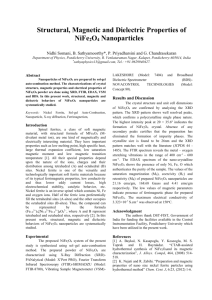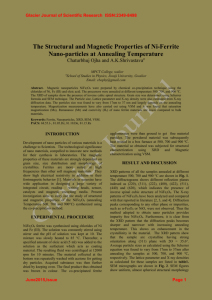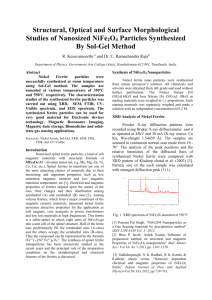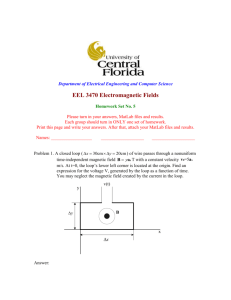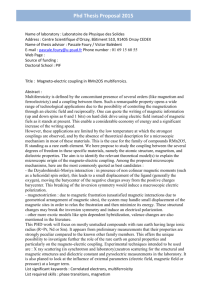effect of firing temperature and compacting pressure on the
advertisement
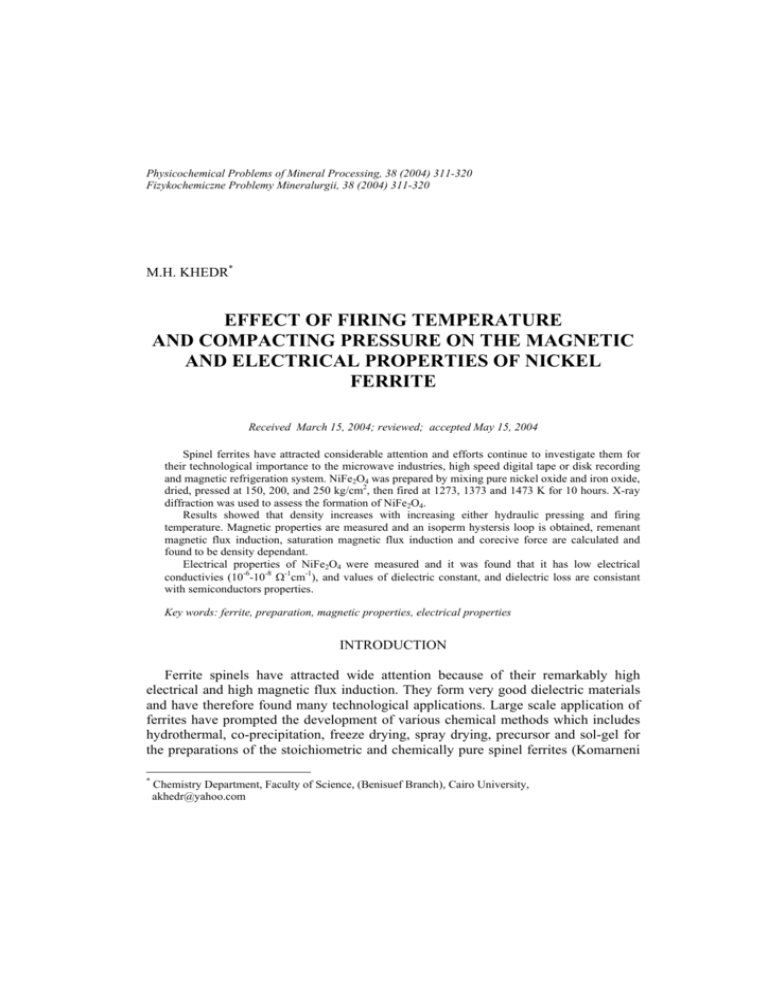
Physicochemical Problems of Mineral Processing, 38 (2004) 311-320 Fizykochemiczne Problemy Mineralurgii, 38 (2004) 311-320 M.H. KHEDR* EFFECT OF FIRING TEMPERATURE AND COMPACTING PRESSURE ON THE MAGNETIC AND ELECTRICAL PROPERTIES OF NICKEL FERRITE Received March 15, 2004; reviewed; accepted May 15, 2004 Spinel ferrites have attracted considerable attention and efforts continue to investigate them for their technological importance to the microwave industries, high speed digital tape or disk recording and magnetic refrigeration system. NiFe2O4 was prepared by mixing pure nickel oxide and iron oxide, dried, pressed at 150, 200, and 250 kg/cm2, then fired at 1273, 1373 and 1473 K for 10 hours. X-ray diffraction was used to assess the formation of NiFe2O4. Results showed that density increases with increasing either hydraulic pressing and firing temperature. Magnetic properties are measured and an isoperm hystersis loop is obtained, remenant magnetic flux induction, saturation magnetic flux induction and corecive force are calculated and found to be density dependant. Electrical properties of NiFe2O4 were measured and it was found that it has low electrical conductivies (10-6-10-8 Ω-1cm-1), and values of dielectric constant, and dielectric loss are consistant with semiconductors properties. Key words: ferrite, preparation, magnetic properties, electrical properties INTRODUCTION Ferrite spinels have attracted wide attention because of their remarkably high electrical and high magnetic flux induction. They form very good dielectric materials and have therefore found many technological applications. Large scale application of ferrites have prompted the development of various chemical methods which includes hydrothermal, co-precipitation, freeze drying, spray drying, precursor and sol-gel for the preparations of the stoichiometric and chemically pure spinel ferrites (Komarneni * Chemistry Department, Faculty of Science, (Benisuef Branch), Cairo University, akhedr@yahoo.com 312 M.H. Khedr et. al 1988), (Morrish et. al. 1981), (Johnson 1981), (Marcilly et. al. 1970) and (Upadhyay et. al. 2003). These methods are characterized by high cost with respect to conventional ceramic powders prepared by solid – state reaction of mechanically mixed and calcined starting materials. The present investigation deals with the synthesis of NiFe2O4 by solid – state reaction of mechanically mixed, pressed and uncalcined iron(III) oxide and Ni(II) oxide powder. (Randhawa et al. 1997) studied the preparation of NiFe2O4 from thermolysis of nickel hexa (forrato) ferrate(III) hexahydrate which shows a very well saturation magnetization (4440 G) and its potential to function at high frequencies. Seema et al. 1998 investigated the magnetic properties of nanosized NiFe2O4 particles synthesized by the citrate precursor technique, single domain particles were found to form linear chain like clusters because of strong magnetic dipole interactions, the low saturation magnetization values were attributed to the spin non collinearity predominantly at the surface. The Hopkinson effect is exhibited by an assembly of non interacting single domains particles and is explained within mathematical formation given by the Stonerad Wohlfarh model. Hana et al.1999 studied the preparation of NiFe2O4 by ceramic and wet methods. They found that AC resitivity, dielectric constant decreased with increasing frequency while dielectric loss and loss tangent went through peak values at the relaxation frequency. EXPERIMENTAL A mixture (1:1 mole ratio) of analar grade NiO and Fe2O3 were employed as raw materials, wet milled with ethanol in a ball mill for 8 hours to ensure homogenity. Samples were dried for 4 hours at 353 K and then equal wights of approximately 1.5 g powder mixture were pressed in a cylindrical mould of 10 mm inner diameter into cylindrical briquette at 150, 200 and 250 kg/cm2. The dry samples were gradually heated in air using a muffle furnace at 1273, 1373 and 1473 K for 10 hours. The fired samples were left to cool gradually to avoid cracking due to thermal shocks. XRD powder patterns were obtained using SHIMADZU – 610-XD diffractometer. The xray generating was equiped with Co filter and generates a beam of CuKα radiation (λ = 1.5418Å). The operational settings for all XRD scans voltage: 40 kV, current 30 mA, Scanning speed 8° min.-1. The structure changes of different samples were examined by reflected light microscope and porosity measurments. Magnetic flux density and remnant magnetic flux density were calculated from hysteresis loop measured by 6900-VS magnetometor. The dielectric properties were measured using a Philips RCL bridge (digital and computerized) at frequency range 60-105 Hz. Effect of firing temperature and compacting pressure on the magnetic and electrical 313 RESULTS AND DISCUSSION Figure 1-a shows a standard X-ray diffraction pattern (Williams et. al. 1994) for NiFe2O4, pure Fe2O3 and pure NiO. X-ray diffraction pattern for NiFe2O4 prepared by firing at 1273 K and compacting pressure 150 kg/cm2 is shown in Fig. 1-b where peaks corresponds to NiFe2O4 and others of lower intensity refered to Fe2O3 and NiO are observed. Fig. 1. Standard X-ray diffractogram for NiFe2O4, Fe2O3 and NiO From diffractograms in Figures 1 c-f as can be noticed are very similar showing NiFe2O4 phase only with the absence of Fe2O3 and NiO phases, the only observation is the increase in the intensity of peaks due to crystallization as results of increasing temperature and or compacting pressure. Spectra of other samples are not mentioned as they are basically the same. M.H. Khedr 314 POROSITY AND DENSITY MEASUREMENTS Table 1 shows the effect of changing compacting pressure and firing temperature on the density of the prepared samples of NiFe2O4. It is clear that increasing the temperature causes an increase in density which is attributed to sintering (Rosales et al.1995). At compacting pressure 250 Kg/cm2 density changes from 2.8 to 4.02 g/cm3 for a change in temperature from 1273 to 1473 K (Figure 2). On the other hand compacting pressure has a very small effect on density. Figures 3 a-c show the photomicrographs of samples compacted at 250 Kg/cm2 and fired at 1273,1373 and 1473 K, respectively. Figure 3-a shows a highly porous structure with a small number of large ferrite grains, at 1373 K (Fig. 3-b) a densification is observed leading to larger grains of NiFe2O4, by increasing the firing temperature to 1473 K ( Fig. 3-c) a dense matrix of connected ferrite grains are observed with the decrease in porosity (Table 1). Table 1. Effect of compacting pressure and firing temperature on density of the prepared NiFe2O4 Firing temperature, K 2 Compacting pressure, Kg/cm 150 200 250 1273 2.682 2.773 2.809 1373 3.049 3.014 2.929 1473 3.584 3.314 4.027 MAGNETIC PROPERTIES The desired technological properties of ferrites depends on stoichiometry, density and crystal structure of ferrite in order to know the distribution of the ions over the available sites in the compound. 6.0 1273 K 1373 K 1473 K 5.5 Density, g/cm 3 5.0 4.5 4.0 3.5 3.0 140 160 180 200 220 240 260 2 Compacting pressure , kg/ cm Fig. 2. Effect of Compacting pressure on the density of the prepared NiFe2O4 Effect of firing temperature and compacting pressure on the magnetic and electrical b 315 c a Fig. 3. Photomicrograph of NiFe2O4 prepared by compacting at 250 Kg/cm2 at a) 1273 K b) 1373 K c) 1473 K, X 600 NiFe2O4 has an invers spinel structure, in natural spinel the eight divalent ions are in the eight available tetrahedral sites and the sixteen trivalent ions in the sixteen octahedral, in case of NiFe2O4 the order is changed and the eight divalent ions (Ni+2) in eight of the sixteen available octahedral sites and the sixteen trivalent (Fe3+) ions uniformely distributed over the remaining sites (Bhise et. al. 1991). Magnetic properties for NiFe2O4 samples were measured, all samples show isoperm (of relatively equal permeability) hystersis loops which describes the relation between external magnetic field H and magnetic flux induction B (Figure 4). Table 2 shows values of saturation magnetic flux induction (Bs), remnant magnetic flux induction (Br) and corecive force (Hc) for samples prepared at different conditions. Figure 4 shows hystersis loops for samples prepared at compacting pressure 200 Kg/cm2, firing temperature 1273, 1373 and 1473 K, it is clear that increasing temperature has a pronounced effect on the size of the hystersis loop which is arised from the change in Br, Bs and Hc. Figure 5 shows the dependence of Br, Bs and Hc on temperature for this sample. Saturation magnetic flux density increases with increasing temperature which is attributed to the decrease in the inter and intragranular pores resulting from increasing firing temperature (Fig. 3-c). The presence of such 316 M.H. Khedr pores causes a discontinuity which prevents the movement of domain walls. Remnant magnetic induction shows a very small change with temperature. On the other hand the coercive force decreases clearly with increasing temperature (Fig. 5). If remenance simply corresponds to a return of the magnetization vectors to the nearest easy direction, while each grain reactions saturated, then remnance and saturation should retains approximately close Bs/Br value. The pores gives rise to demagnetizing fields which could either cause rotation of the magnetization away from the easy direction or the nucleation of reverse domains in which case it is surprising that Bs/Br should be greater for the more porous sample (Heck 1967), (Table 2). However the denser sample, when prepared by firing at higher temperature, will also contain larger grains in which nucleation is more probable. Fig. 4. B-H Hystersis loops for NiFe2O4 prepared by compacting at 250 Kg/cm2 at a) 1273K. b)1373K c) 1473K The effects of intragranular pores on the corecivity arises from the impedance of the motion of the domain wall. It has been noted that the magnetization processes in NiFe2O4 consists of discontinous movements of walls over considerable distances of the sudden rearrangements of the structures within entire grains, indicating the presence of large–scale discontinuties which may have been groups of pores. The direct interaction of domain walls with pores, including the formation subsidiary tiedomains, has been demonstrated by Knowle (Heck 1967). Effect of firing temperature and compacting pressure on the magnetic and electrical 317 Fig. 5. Dependence of magnetic properties on the firing temperature of NiFe2O4 Table 2. Variation of the magnetic properties for samples prepared at different conditions Preparation conditions Compacting presuure 150 Kg/cm2 200 Kg/cm2 250 Kg/cm2 Firing Temp., K 1273 1373 1473 1273 1373 1473 1273 1373 1473 Bs, emu/g Br, emu/g Bs/Br Hc, Oe 23 29.8 33.4 25.34 29.57 32.95 22.86 30.1 34.11 12.1 14.4 13.94 13.22 14.51 14.81 11.99 14.98 14.78 1.9 2.06 2.39 1.91 2.03 2.20 1.90 2.00 2.30 365 306.8 273.6 365.5 318.8 289.3 353 317 276 ELECTRICAL PROPERTIES The AC electrical conductivity were studied as a function of frequency for a series of NiFe2O4 samples prepared at different conditions of firing temperature and compacting pressure. All samples showed a conductivity ranging from 10–6 to 10–8 Ω1 cm-1, this is explained by the fact that NiFe2O4 forms a cubic close-packed oxygen lattice with the metal ions situated at the tetrahedral (A) and octahedral (B) sites. Electronic conduction in these ferrites can be explained in terms of the verwey mechanism (Yajie et. al. 1995) which consists of electrons exchange between ions of the same element present in more than one valency state distributed randomly over crystalographically equivalent lattice sites. The expected hopping mechanism is Ni+2 + Fe+3 → Ni +3 + Fe+2 318 M.H. Khedr Because Fe+2 ions preferentially occupies the B site, A-A hoping therefore does not take place. Moreover, as the B-B distance is smaller than A-B distance, electron hoping between B-B ions becames the main mechanism of conduction. The logarithmic relation between electrical conductivity and frequency as represented in Figure 6 indicates that conductivity increases slightly on increasing frequency. The small value at low frequencies and their increase as frequency increases can be explained on the basis of Maxwell-Wagner theory (Koops 1951), which is a result of the inhomogenous nature of dielectric structure. The dielectric structure was supposed as composed of two layers. The first is the large ferrite grains of fairly well conducting materials which are separated by the second thin layer (grain boundaries) of relatively poor conducting substances. These grain boundries were formed by superficial reduction or oxidation of the crystallites in the porous material as a result of their direct contact with firing atmosphere. The resistive grain boundaries were found to be more effective at lower frequencies while the conductive ferrite grains are more effective at higher frequencies. For all samples the same trend was observed, the effect of firing temperature and compacting pressure shows a very small difference in conductivity with frequency. Figure 7 shows the effect of changing frequency with dielectric constant ε`, the general trend for all investigated samples is the decrease in its value with increasing frequency which is a normal dielectric behaviour in ferrites. This decrease in dielectric polarization is due to the fact that beyond a certain frequency, the hopping of electrons between Fe+3 and Fe+2 can not follow the frequency of the alternating electric field. In other word, the low frequency helps in aligning more dipoles in the field direction with the result of an increase in the polarization as well as ε`, while by increasing frequency, the dipoles are distributed and ε` decreases (Reddy et. al. 1999). The dependence of dielectric loss ε`` on frequency at room temperature is shown in Figure 8. It is clear that ε``(energy dissipated per cycle) decreases with increasing frequency. It is very important to emphasize that the ac dielectric response of concentrated charge – carriers-containing materials is strongly affected by the charge contribution to the total sample polarizability, mainly at lower frequencies (Dias et. al. 1998). Fig. 6. Frequency dependence of log σ for NiFe2O4 prepared by compacting at 200 Kg/cm2 at a) 1273K b)1373K c) 1473K Effect of firing temperature and compacting pressure on the magnetic and electrical 319 Fig. 7. Frequency dependence of dielectric constant (ε`) for NiFe2O4 prepared by compacting a) 1273K b)1373K c) 1473K at 200 Kg/cm2 at Fig. 8. Frequency dependence of dielectric loss (ε``) for NiFe2O4 prepared by compacting at 250 kg/cm2 at a) 1273K b)1373K c) 1473K CONCLUSION The density of NiFe2O4 prepared by mixing pure nickel oxide and iron oxide with no calcination was found to be strongly affected by firing temperature and compacting pressure. 320 M.H. Khedr The increase in density causes a great improvement in the magnetic properties: isoperm hysterisis loop is obtained , saturation magnetic flux induction increased while coercive force decreased. Electrical properties of samples shows low electrical conductivies (10-6-10-8 Ω-1cm-1). Values of dielectric constant, dielectric loss and magnetic properties indicates that it could be used in many technological application. REFERENCES BHISE B., DONGAR M., PATIL S., SAWANT S.(1991), Mater. Sci. Lett. Vol. 10 , pp. 992 . DIAS A., MOREIRA R. (1998), Mater. Res., Vol. 8 , pp. 2190 . Heck C. (1967), Magnetic materials and their applications, London , Butterworths , pp. 579. JOHNSON D. W. (1981), Am. Ceram. Soc. Bull., Vol. 60 , pp. 221 . KOMARNENI S., FREGEAU E., BREVAL E. (1988), J. Am. Ceram. Soc. Commun.,Vol. 71, pp. 26 . KOOPS C. (1951), Phys. Rev., Vol. 38 , pp. 216. MARCILLY C.H., COURTY P., DELMON B. (1970), J. Am. Ceram. Soc.,Vol. 53 pp. 56 . MORRISH A.H., HANEDA K. (1981), J. Appl. Phys., , Vol. 52 , pp. 2696 . MOUSTAF I. (1999), Ph.D. Thesis, Faculty of Engineering , Cairo Univ.,pp. 68 . PARASAD S., GAJBHIYE N.S (1998), Alloys and compounds, Vol. 265 , pp. 87 . RANDHAWA B., SINGH R. (1997), De-Physique, IV; Vol. 7, pp. 89 . REDDY A.R., MOHN G. R., RAVINDER D., BOYANOV B. (1999), Mater. Sci. J., Vol. 34, pp. 3169 . ROSALES M.I. , PLATA A.M., NICHO M.E., BRITO A., PONCE M., CASTANO V. (1995), Mater. Science J., Vol. 30 pp. 4446 . UPADHYAY C., MISHRA D., VERMA H.C., ANAND S., DAS R.P. (2003), Magnet. and Mag. Mater., Vol. 260 pp. 188 . WILLIAMS C.M., ABE M., ITOH T.. LUPITZ P. (1994), IEEE Trans. on Magnet., Vol. 30, pp. 4896. YAJIE C., PEISHENG L., ZONGMING J. (1995), Mater. Sci. Lett. Vol. 14 , pp. 998 . Khedr M.H., Wpływ temperatury wypalania i ciśnienia sprasowania na magnetyczne i elektryczne właściwości ferytu niklowego, Physicochemical Problems of Mineral Processing, 38, (2004) 311-320 (w jęz. ang.). Spinele ferytowe ciągle wzbudzają duże zainteresowanie oraz wymagają dalszych intensywnych badań z uwagi na ich znaczenie technologiczne. Znajdują one liczne zastosowanie w przemyśle do produkcji urządzeń mikrofalowych, taśm magnetycznych do szybkiego zapisu, dysków do kmputerów oraz magnetycznych układów chłodżących. NiFe2O3 był otrzymany przez zmieszanie tlenku niklu z tlenkiem żelaza, ogrzanie mieszaniny pod ciśnieniem 150, 200 i 250 kg/cm2, następnie, materiał był wyprażany w temperaturach 1273, 1373 i 1473 K przez 10 godzin. Analizę otrzymanego materiału dokonano metodą dyfrakcji rentgenowskiej. Otrzymane wyniki badań wskazują, że gęstość materiału wzrasta wraz ze wzrostem ciśnienia i temperatury stosowanej w syntezie. Właściwości magnetyczne otrzymanego produktu zostały zbadane. Określono histerezę magnetyczną dla badanego materiału. Wyliczone zostały inne parametry magnetyczne jak szczątkowy i nasycony strumień indukcji magnetycznej. Wszystkie te parametry okazały się być zależne od gęstości otrzymanych ferytów. Podobnie zostały zmierzone właściwości elektryczne NiFe2O3. Okazało się, że spinele miały małę przewodnictwo elektryczne (10-6-10-8 Ω-1cm-1), a stała dielektryczna była zgodna z wartościami odpowiadającymi półprzewodnikom.
